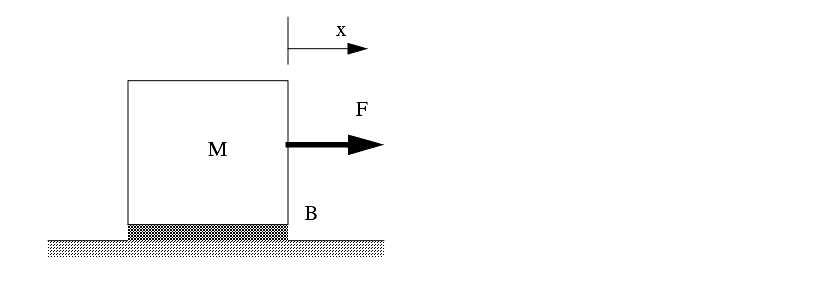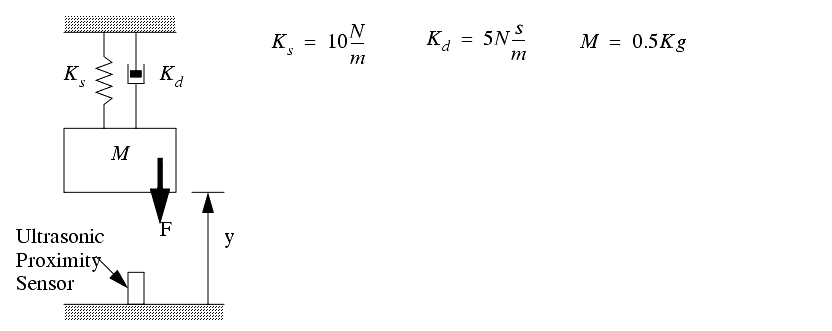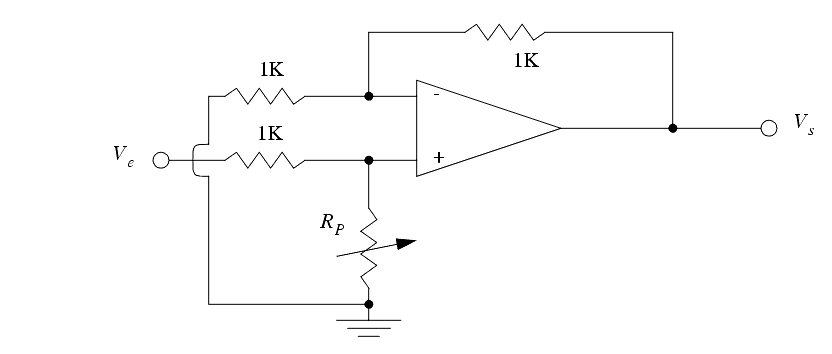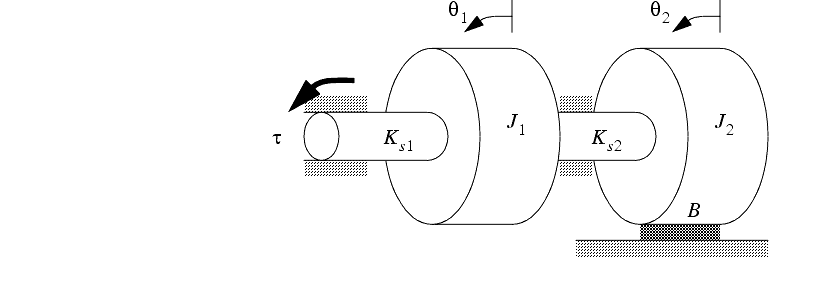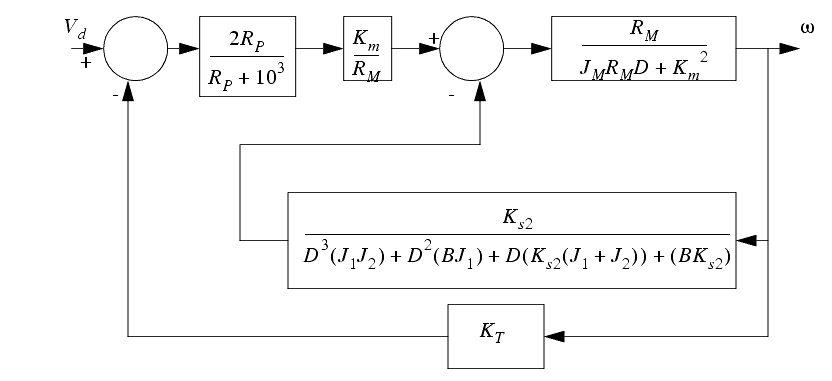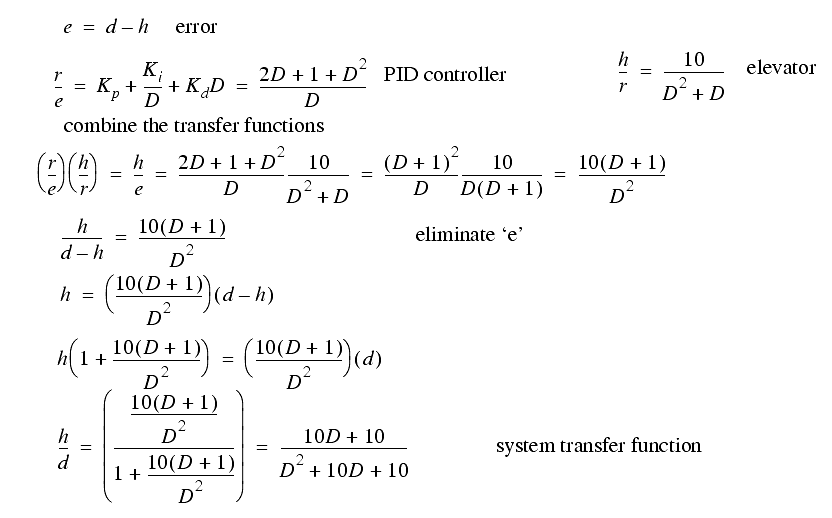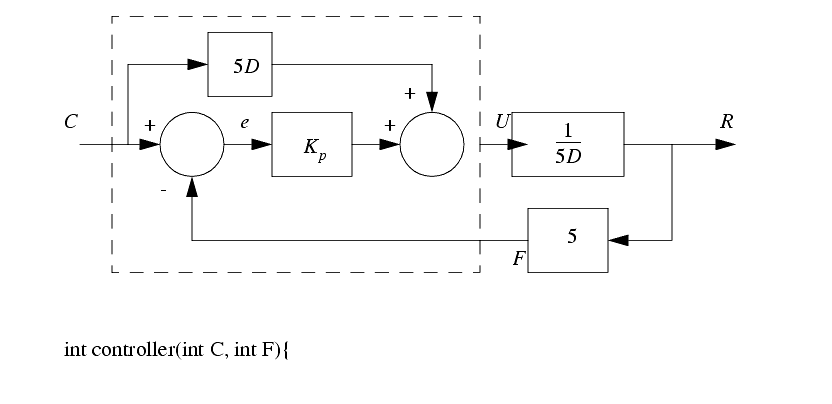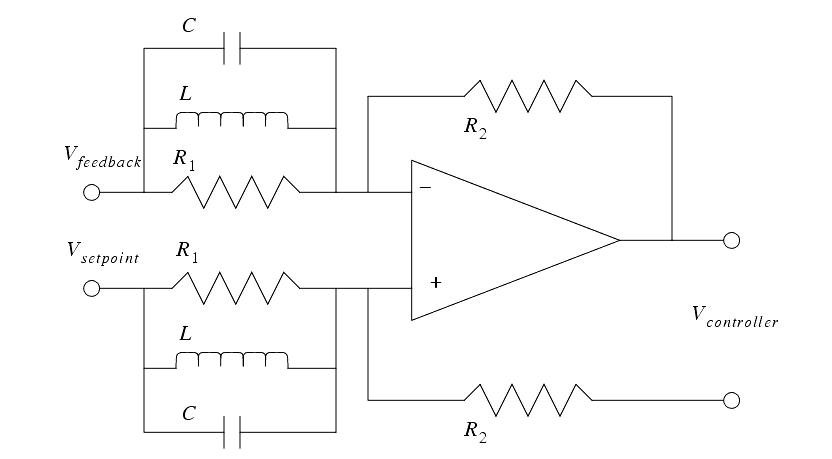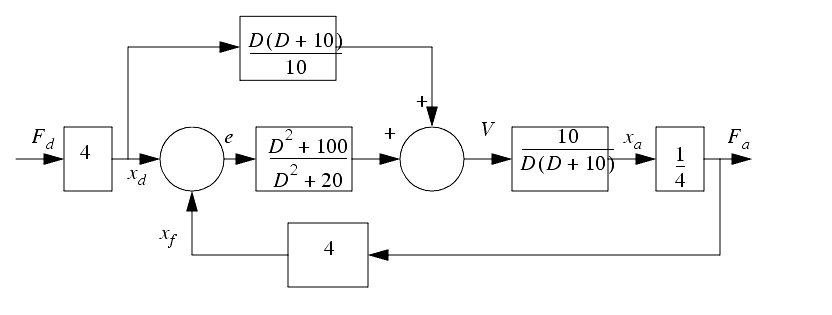8.6 PRACTICE PROBLEMS
������������
1. Develop differential equations and then transfer functions for the mechanical system below. There is viscous damping between the block and the ground. A force is applied to cause the mass the accelerate.
2. Develop a transfer function for the system below. The input is the force `F' and the output is the voltage `Vo'. The mass is suspended by a spring and a damper. When the spring is undeflected y=0. The height is measured with an ultrasonic proximity sensor. When y = 0, the output Vo=0V. If y=20cm then Vo=2V and if y=-20cm then Vo=-2V. Neglect gravity.
3. Find the transfer function for the systems below. Here the input is a torque, and the output is the angle of the second mass.
4. Find the transfer functions for the system below where Vi is the input and Vo is the output.
5. Given the transfer function, G(s), determine the time response output Y(t) to a step input X(t).
6. Given the transfer function below, develop a mechanical system that it could represent. (Hint: Differential Equations).
7. Given a mass supported by a spring and damper, find the displacement of the supported mass over time if it is released from neutral at t=0sec, and gravity pulls it downward.
a) develop a transfer function for y/F.
b) find the input function F.
c) solve the input output equation to find an explicit equation of the position as a function of time for Ks = 10N/m, Kd = 5Ns/m, M=10kg.
d) solve part c) numerically.
8. a) What is a Setpoint, and what is it used for? b) What does feedback do in control systems?
9. The block diagram below is for a servo motor position control system. The system uses a proportional controller.
a) Draw a sketch of what the actual system might look like. Identify components.
b) Convert the system to a transfer function.
10. Simplify the block diagram below to a transfer function.
11. Simplify the block diagram below. (Note: Vn is an input and cannot be combined in a transfer function.)
12. a) Develop an equation for the system below relating the two inputs to the output. Put it in block diagram format. (Hint: think of a summation block.)
b) Develop an equation for the system below relating the input to the output. Put the result in block diagram format.
c) The equation below can be used to model a permanent magnet DC motor with an applied torque. An equivalent block diagram is given. Prove that the block diagram is equivalent to the equation.
d) Write the transfer function for the system below relating the input torque to the output angle theta2. Then write the transfer function for the angular velocity of mass 2.
e) The system below is a combination of previous components, and a tachometer for velocity feedback. Simplify the block diagram.
13. Find the system output, feedback error and system error when the input is a ramp with the function c(t) = 0.5t. Sketch the system errors as a function of time.
14. Given the block diagram below, select a system gain K that will give the overall system a damping ratio of 0.7 (for a step input). What is the resulting damped frequency of the system?
15. The following system is a feedback controller for an elevator. It uses a desired height `d' provided by a user, and the actual height of the elevator `h'. The difference between these two is called the error `e'. The PID controller will examine the value `e' and then control the speed of the lift motor with a control voltage `c'. The elevator and controller are described with transfer functions, as shown below. all of these equations can be combined into a single system transfer equation as shown.
a) Find the response of the final equation to a step input. The system starts at rest on the ground floor, and the input (desired height) changes to 20 as a step input.
b) Calculate the damping factor and natural frequency of the results in part a).
16. Study the circuit below. Assume that for t<0s the circuit is discharged and off. Starting at t=0s an input of Vi=5sin(100,000t) is applied.
a) Write a differential equation and then a transfer function describing the circuit.
b) Find the output of the circuit using explicit integration (i.e., homogeneous and particular solutions).
17. Write a C subroutine to implement the control system that is shown inside the dashed line. The subroutine arguments are the setpoint, C, and the feedback value, F. the subroutine returns the new controller output value, U.
18. Convert the following block diagram to state equations. Pick a K value that would leave the system critically damped.
19. Write a function in C that implements a PID function using the following function prototype. The function accepts the desired and current values and returns the controller output.
20. Simplify the block diagram below to a transfer function.
21. Write the differential equation for the control system below.
22. Simplify the block diagram below and find the overall transfer function for the system.
23. Develop a transfer function for the following system. The input is Vd and the output is the motor shaft position. Assume all components are ideal. The motor has a resistance of 10 ohms. With an input voltage of 4V the motor spins at 4000RPM (steady state), and has a time constant of 0.1s. When the potentiometer is rotated +180 degrees the output is 5V, a rotation of -180 degrees results in an output of -5V.
24. a) Simplify the block diagram as far as possible.
b) Given the transfer function below, select values for Kp and tau that will include a second order response that has a damping factor of 0.125 and a natural frequency of 10rad/s.
c) The function below has a step input of magnitude 1.0. Find the output as a function of time using numerical methods. Give the results in a table OR graph.
d) The function below has a step input of magnitude 1. Find the output as a function of time by integrating the differential equation (i.e., using the homogeneous and particular solutions).
e) Select a controller transfer function, Gc, that will reduce the system to a first order system with a time constant of 0.5s, as shown below.
